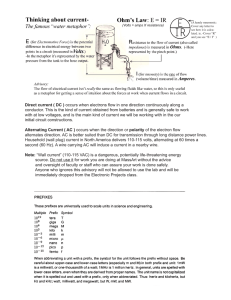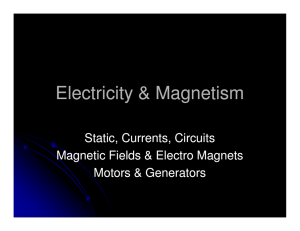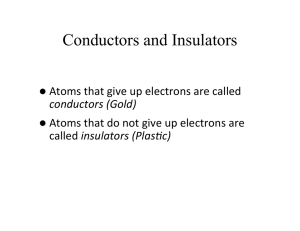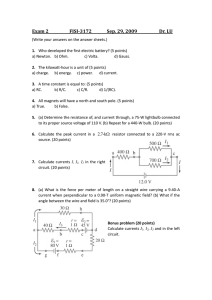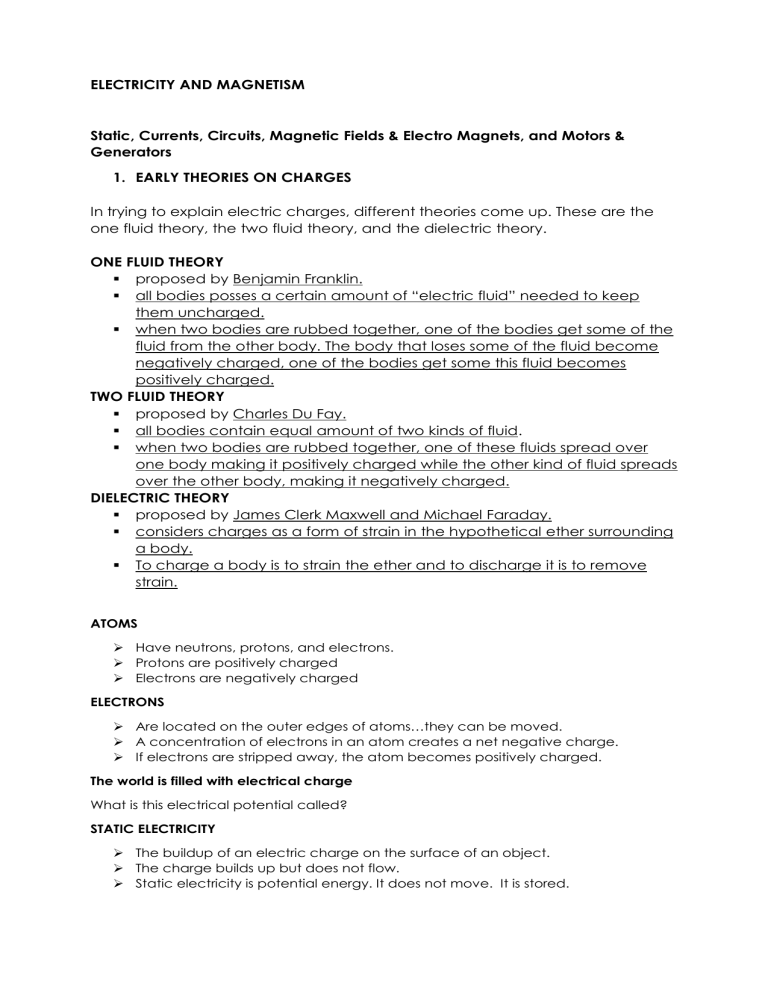
ELECTRICITY AND MAGNETISM Static, Currents, Circuits, Magnetic Fields & Electro Magnets, and Motors & Generators 1. EARLY THEORIES ON CHARGES In trying to explain electric charges, different theories come up. These are the one fluid theory, the two fluid theory, and the dielectric theory. ONE FLUID THEORY proposed by Benjamin Franklin. all bodies posses a certain amount of “electric fluid” needed to keep them uncharged. when two bodies are rubbed together, one of the bodies get some of the fluid from the other body. The body that loses some of the fluid become negatively charged, one of the bodies get some this fluid becomes positively charged. TWO FLUID THEORY proposed by Charles Du Fay. all bodies contain equal amount of two kinds of fluid. when two bodies are rubbed together, one of these fluids spread over one body making it positively charged while the other kind of fluid spreads over the other body, making it negatively charged. DIELECTRIC THEORY proposed by James Clerk Maxwell and Michael Faraday. considers charges as a form of strain in the hypothetical ether surrounding a body. To charge a body is to strain the ether and to discharge it is to remove strain. ATOMS Have neutrons, protons, and electrons. Protons are positively charged Electrons are negatively charged ELECTRONS Are located on the outer edges of atoms…they can be moved. A concentration of electrons in an atom creates a net negative charge. If electrons are stripped away, the atom becomes positively charged. The world is filled with electrical charge What is this electrical potential called? STATIC ELECTRICITY The buildup of an electric charge on the surface of an object. The charge builds up but does not flow. Static electricity is potential energy. It does not move. It is stored. STATIC DISCHARGE Occurs when there is a loss of static electricity due to three possible things: Friction - rubbing Conduction – direct contact Induction – through an electrical field (not direct contact) ELECTRICITY THAT MOVES Current: The flow of electrons from one place to another. Measured in amperes (amps) Kinetic energy HOW CAN WE CONTROL CURRENTS? With circuits. Circuit: is a path for the flow of electrons. We use wires. THERE ARE 2 TYPES OF CURRENTS: Direct Current (DC) – Where electrons flow in the same direction in a wire. Alternating Current (AC) – electrons flow in different directions in a wire THERE ARE 2 TYPES OF CIRCUITS: Series Circuit: the components are lined up along one path. If the circuit is broken, all components turn off. Parallel Circuit – there are several branching paths to the components. If the circuit is broken at any one branch, only the components on that branch will turn off. CONDUCTORS VS. INSULATORS Conductors – material through which electric current flows easily. Insulators – materials through which electric current cannot move. Examples CONDUCTORS: INSULATORS: Metal Water Styrofoam Rubber Plastic Paper WHAT IS RESISTANCE? The opposition to the flow of an electric current, producing heat. The greater the resistance, the less current gets through. Good conductors have low resistance. Measured in ohms. WHAT INFLUENCES RESISTANCE? Material of wire – aluminum and copper have low resistance Thickness – the thicker the wire the lower the resistance Length – shorter wire has lower resistance Temperature – lower temperature has lower resistance WHAT IS VOLTAGE? The measure of energy given to the charge flowing in a circuit. The greater the voltage, the greater the force or “pressure” that drives the charge through the circuit. DIFFERENCE BETWEEN VOLTS AND AMPS Example – you could say that… Amps measure how much water comes out of a hose. Volts measure how hard the water comes out of a hose. OHM’S LAW Resistance = Voltage / Current Ohms = Volts / Amps WHAT IS AN ELECTROMAGNET? Electromagnet – a magnet made from a current bearing coil of wire wrapped around an iron or steel core. WHAT IS A GENERATOR? Generator – a machine that changes mechanical energy to electrical energy Usually use moving magnets to create currents in coils of wire. WHAT IS A MOTOR? Motor – a device that changes electrical energy to mechanical energy that can do work. Watts = Amps x Volts Amps = Watts / Volts Volts = Watts / Amps



